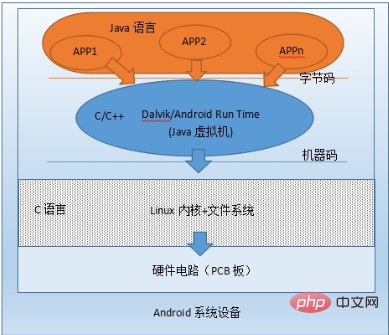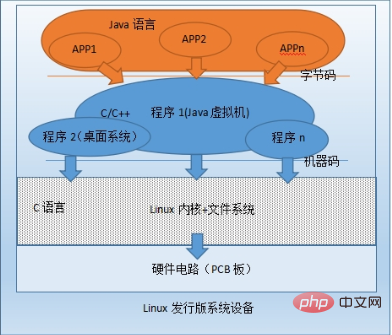 Operation and Maintenance
Operation and Maintenance
 Linux Operation and Maintenance
Linux Operation and Maintenance
 What are the differences between linux and android?
What are the differences between linux and android?
What are the differences between linux and android?

What are the differences between linux and android?
There are three differences:
1. Android does not have a local window system, while Linux has an X window system.
2. Android does not have glibc support, but Linux does have glibc support.
3. Android has its own proprietary driver.
Although Android is based on the Linux kernel, there are still big differences between it and Linux.


Extended information
Android proprietary driver
1. Android Binder is a driver based on the OpenBinder framework and is used to provide the inter-process communication (InterProcess Communication, IPC) function of the Android platform. The source code is located in drivers/staging/android/binder.c.
2. Android Power Management (PM) A lightweight Android power management driver based on the standard Linux power management system, which has been optimized for embedded devices. The source code is located at:
kernel/power/earlysuspend.c kernel/power/consoleearlysuspend.c kernel/power/fbearlysuspend.c kernel/power/wakelock.c kernel/power/userwakelock.c
3. Low Memory Killer (Low Memory Killer) is more flexible than Linux's standard OOM (Out Of Memory) mechanism. It can kill processes as needed to release the required memory. The source code is located in drivers/staging/android/lowmemorykiller.c.
4. Anonymous shared memory (Ashmem) provides large blocks of shared memory between processes and provides the kernel with a mechanism to recycle and manage this memory. The source code is located in mm/ashmem.c.
5. Android PMEM (Physical) PMEM is used to provide a continuous physical memory area to the user space. DSP and some devices can only work on continuous physical memory. The source code is located in drivers/misc/pmem.c.
6. Android Logger is a lightweight log device used to capture various logs of the Android system. The source code is located in drivers/staging/android/logger.c.
7. Android Alarm provides a timer for waking the device from sleep, and it also provides a clock base that will run even when the device is sleeping. The source code is located in drivers/rtc/alarm.c.
8. USB Gadget driver A device driver based on the standard Linux USB gadget driver framework. Android's USB driver is based on the gaeget framework. The source code is located in drivers/usb/gadget/.
9. Android Ram Console In order to provide debugging functions, Android allows debugging log information to be written to a device called RAM Console, which is a RAM-based Buffer. The source code is located in drivers/staging/android/ram_console.c.
10. Android timed device provides the function of timing control of the device. It currently supports vibrator and LED devices. The source code is located in drivers/staging/android/timed_output.c(timed_gpio.c).
Recommended tutorial: "Linux Video Tutorial"
The above is the detailed content of What are the differences between linux and android?. For more information, please follow other related articles on the PHP Chinese website!

Hot AI Tools

Undresser.AI Undress
AI-powered app for creating realistic nude photos

AI Clothes Remover
Online AI tool for removing clothes from photos.

Undress AI Tool
Undress images for free

Clothoff.io
AI clothes remover

Video Face Swap
Swap faces in any video effortlessly with our completely free AI face swap tool!

Hot Article

Hot Tools

Notepad++7.3.1
Easy-to-use and free code editor

SublimeText3 Chinese version
Chinese version, very easy to use

Zend Studio 13.0.1
Powerful PHP integrated development environment

Dreamweaver CS6
Visual web development tools

SublimeText3 Mac version
God-level code editing software (SublimeText3)

Hot Topics
 1387
1387
 52
52
 How to use docker desktop
Apr 15, 2025 am 11:45 AM
How to use docker desktop
Apr 15, 2025 am 11:45 AM
How to use Docker Desktop? Docker Desktop is a tool for running Docker containers on local machines. The steps to use include: 1. Install Docker Desktop; 2. Start Docker Desktop; 3. Create Docker image (using Dockerfile); 4. Build Docker image (using docker build); 5. Run Docker container (using docker run).
 How to view the docker process
Apr 15, 2025 am 11:48 AM
How to view the docker process
Apr 15, 2025 am 11:48 AM
Docker process viewing method: 1. Docker CLI command: docker ps; 2. Systemd CLI command: systemctl status docker; 3. Docker Compose CLI command: docker-compose ps; 4. Process Explorer (Windows); 5. /proc directory (Linux).
 What to do if the docker image fails
Apr 15, 2025 am 11:21 AM
What to do if the docker image fails
Apr 15, 2025 am 11:21 AM
Troubleshooting steps for failed Docker image build: Check Dockerfile syntax and dependency version. Check if the build context contains the required source code and dependencies. View the build log for error details. Use the --target option to build a hierarchical phase to identify failure points. Make sure to use the latest version of Docker engine. Build the image with --t [image-name]:debug mode to debug the problem. Check disk space and make sure it is sufficient. Disable SELinux to prevent interference with the build process. Ask community platforms for help, provide Dockerfiles and build log descriptions for more specific suggestions.
 vscode cannot install extension
Apr 15, 2025 pm 07:18 PM
vscode cannot install extension
Apr 15, 2025 pm 07:18 PM
The reasons for the installation of VS Code extensions may be: network instability, insufficient permissions, system compatibility issues, VS Code version is too old, antivirus software or firewall interference. By checking network connections, permissions, log files, updating VS Code, disabling security software, and restarting VS Code or computers, you can gradually troubleshoot and resolve issues.
 What computer configuration is required for vscode
Apr 15, 2025 pm 09:48 PM
What computer configuration is required for vscode
Apr 15, 2025 pm 09:48 PM
VS Code system requirements: Operating system: Windows 10 and above, macOS 10.12 and above, Linux distribution processor: minimum 1.6 GHz, recommended 2.0 GHz and above memory: minimum 512 MB, recommended 4 GB and above storage space: minimum 250 MB, recommended 1 GB and above other requirements: stable network connection, Xorg/Wayland (Linux)
 Can vscode be used for mac
Apr 15, 2025 pm 07:36 PM
Can vscode be used for mac
Apr 15, 2025 pm 07:36 PM
VS Code is available on Mac. It has powerful extensions, Git integration, terminal and debugger, and also offers a wealth of setup options. However, for particularly large projects or highly professional development, VS Code may have performance or functional limitations.
 What is vscode What is vscode for?
Apr 15, 2025 pm 06:45 PM
What is vscode What is vscode for?
Apr 15, 2025 pm 06:45 PM
VS Code is the full name Visual Studio Code, which is a free and open source cross-platform code editor and development environment developed by Microsoft. It supports a wide range of programming languages and provides syntax highlighting, code automatic completion, code snippets and smart prompts to improve development efficiency. Through a rich extension ecosystem, users can add extensions to specific needs and languages, such as debuggers, code formatting tools, and Git integrations. VS Code also includes an intuitive debugger that helps quickly find and resolve bugs in your code.
 How to back up vscode settings and extensions
Apr 15, 2025 pm 05:18 PM
How to back up vscode settings and extensions
Apr 15, 2025 pm 05:18 PM
How to back up VS Code configurations and extensions? Manually backup the settings file: Copy the key JSON files (settings.json, keybindings.json, extensions.json) to a safe location. Take advantage of VS Code synchronization: enable synchronization with your GitHub account to automatically back up all relevant settings and extensions. Use third-party tools: Back up configurations with reliable tools and provide richer features such as version control and incremental backups.



